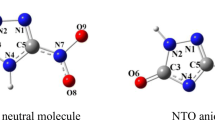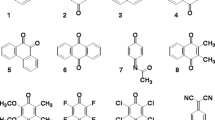Abstract
The reactivity of 5-fluoro-1H,3H-pyrimidine-2,4-dione (5-fluorouracil), which is widely used to treat cancer, toward superoxide radical anion (O2•−) and hydroperoxyl radical (HO2•) was investigated using density functional theory (DFT) calculations. 5-Fluorouracil is a pyrimidine analog with cytotoxic effects on cancer cells and potential ecotoxicology as a recalcitrant compound to the natural environment; therefore, clarifying its chemical degradation mechanism is difficult by way of in vivo and in vitro experiments but important for further usage. The DFT results clarified that the oxidation of 5-fluorouracil by O2•− or HO2• in water is feasible through a proton-coupled electron transfer (PCET) mechanism. In addition, a concerted PCET pathway between 5-fluorouracil and HO2• preformed via the protonation of O2•− is proposed. In this pathway, the amine group at the first position of 5-fluorouracil acts as a reaction site for the concerted PCET after forming a prereactive complex via a hydrogen bond. Considering that the actual oxidant along the PCET pathways is HO2• with a short lifetime, the biodegradability of 5-fluorouracil by O2•− (HO2•) is governed by the complex formation step and the concerted PCET.






Similar content being viewed by others
Availability of data and materials
All data generated or analyzed during this study are included in this published article and its supplementary materials.
Abbreviations
- DFT:
-
Density functional theory
- PCET:
-
Proton-coupled electron transfer
- ROS:
-
Reactive oxygen species
- PT:
-
Proton transfer
- ET:
-
Electron transfer
- SET:
-
Single-electron transfer
- HAT:
-
Hydrogen-atom transfer
- B3LYP:
-
Becke three-parameter Lee–Yang–Parr
- M06-2X:
-
Minnesota 06
- HOMO:
-
Highest occupied molecular orbital
- LUMO:
-
Lowest unoccupied molecular orbital
- PCM:
-
Polarized continuum model
- NBO:
-
Natural bond orbital
- NH:
-
Amine group
- SOMO:
-
Singly occupied molecular orbital
- PRC:
-
Prereactive complex
- HB:
-
Hydrogen bond
References
Azwar S, Seow HF, Abdullah M et al (2021) Recent updates on mechanisms of resistance to 5-fluorouracil and reversal strategies in colon cancer treatment. Biology (Basel) 10:854. https://doi.org/10.3390/biology10090854
Entezar-Almahdi E, Mohammadi-Samani S, Tayebi L, Farjadian F (2020) Recent advances in designing 5-fluorouracil delivery systems: a stepping stone in the safe treatment of colorectal cancer. Int J Nanomedicine 15:5445–5458. https://doi.org/10.2147/IJN.S257700
Sethy C, Kundu CN (2021) 5-Fluorouracil (5-FU) resistance and the new strategy to enhance the sensitivity against cancer: implication of DNA repair inhibition. Biomed Pharm 137. https://doi.org/10.1016/j.biopha.2021.111285
Longley DB, Harkin DP, Johnston PG (2003) 5-Fluorouracil: mechanisms of action and clinical strategies. Nat Rev Cancer 3:330–338. https://doi.org/10.1038/nrc1074
Yen Moore A (2009) Clinical applications for topical 5-fluorouracil in the treatment of dermatological disorders. J Dermatol Treat 20:328–335. https://doi.org/10.3109/09546630902789326
Gamelin E, Boisdron-Celle M (1999) Dose monitoring of 5-fluorouracil in patients with colorectal or head and neck cancer—status of the art. Crit Rev Oncol Hematol 30:71–79. https://doi.org/10.1016/S1040-8428(98)00036-5
Felici A, Verweij J, Sparreboom A (2002) Dosing strategies for anticancer drugs: the good, the bad and body-surface area. Eur J Cancer 38:1677–1684. https://doi.org/10.1016/S0959-8049(02)00151-X
Venter C, Eyerich S, Sarin T, Klatt KC (2020) Nutrition and the immune system: a complicated tango. Nutrients 12:818. https://doi.org/10.3390/nu12030818
Zoghi S, Masoumi F, Rezaei N (2023) The immune system. In: Clinical Immunology. Academic Press, pp 1–46
Li X, Lv G, Wang N et al (2022) Theoretical insights into the transformation mechanism and eco-toxicity effects of 5-Fluorouracil by O3 and ·OH in waters. Process Saf Environ Prot 160:541–550. https://doi.org/10.1016/J.PSEP.2022.02.045
Javitt L, Dror I, Berkowitz B (2019) Catalytic degradation of fluorouracil and its derivatives by copper-based nanoparticles. Environ Eng Sci 36:1466–1473. https://doi.org/10.1089/ees.2019.0210
Governo M, Santos MSF, Alves A, Madeira LM (2017) Degradation of the cytostatic 5-fluorouracil in water by Fenton and photo-assisted oxidation processes. Environ Sci Pollut Res 24:844–854. https://doi.org/10.1007/s11356-016-7827-2
Nanni EJ, Birge RR, Hubbard LM et al (1981) Oxidation and dismutation of superoxide ion solutions to molecular oxygen. singlet vs. triplet state. Inorg Chem 20:737–741. https://doi.org/10.1021/ic50217a019
Nanni EJ, Stallings MD, Sawyer DT (1980) Does superoxide ion oxidize catechol, α-tocopherol, and ascorbic acid by direct electron transfer? J Am Chem Soc 102:4481–4485. https://doi.org/10.1021/ja00533a029
Song C, Zhang J (2008) Electrocatalytic oxygen reduction reaction. PEM Fuel Cell Electrocatalysts and Catalyst Layers. Springer, London, pp 89–134
Biela M, Rimarčík J, Senajová E et al (2020) Antioxidant action of deprotonated flavonoids: thermodynamics of sequential proton-loss electron-transfer. Phytochemistry 180. https://doi.org/10.1016/j.phytochem.2020.112528
Singh PS, Evans DH (2006) Study of the electrochemical reduction of dioxygen in acetonitrile in the presence of weak acids. J Phys Chem B 110:637–644. https://doi.org/10.1021/jp055296f
Nakayama T, Uno B (2015) Importance of proton-coupled electron transfer from natural phenolic compounds in superoxide scavenging. Chem Pharm Bull (Tokyo) 63:967–973. https://doi.org/10.1248/cpb.c15-00447
Nakayama T, Uno B (2016) Structural properties of 4-substituted phenols capable of proton-coupled electron transfer to superoxide. Int J Adv Res Chem Sci 3:11–19. https://doi.org/10.20431/2349-0403.0301002
Nakayama T, Uno B (2022) Reactivities of hydroxycinnamic acid derivatives involving caffeic acid toward electrogenerated superoxide in N, N-dimethylformamide. Electrochem 3:347–360. https://doi.org/10.3390/electrochem3030024
Nakayama T, Uno B (2023) Reactivity of trans-resveratrol toward electrogenerated superoxide in N, N-dimethylformamide. J Agric Food Chem 71:4382–4393. https://doi.org/10.1021/acs.jafc.2c08105
Nakayama T, Uno B (2022) Reactivities of 1,2-, 1,3-, and 1,4-dihydroxynaphthalenes toward electrogenerated superoxide in N, N-dimethylformamide through proton-coupled electron transfer. Electrochim Acta 436:141467. https://doi.org/10.1016/J.ELECTACTA.2022.141467
Nakayama T, Honda R (2021) Electrochemical and mechanistic study of superoxide elimination by Mesalazine through proton-coupled electron transfer. Pharmaceuticals 14:120. https://doi.org/10.3390/ph14020120
Nakayama T, Honda R (2021) Electrochemical and mechanistic study of oxidative degradation of favipiravir by electrogenerated superoxide through proton-coupled electron transfer. ACS Omega 6:21730–21740. https://doi.org/10.1021/acsomega.1c03230
Nakayama T, Uno B (2016) Concerted two-proton-coupled electron transfer from catechols to superoxide via hydrogen bonds. Electrochim Acta 208:304–309. https://doi.org/10.1016/j.electacta.2016.05.034
Nakayama T, Honda R, Kuwata K et al (2022) Electrochemical and mechanistic study of reactivities of α-, β-, γ-, and δ-tocopherol toward electrogenerated superoxide in N, N-dimethylformamide through proton-coupled electron transfer. Antioxidants 11:115–128. https://doi.org/10.3390/antiox11010009
Nakayama T, Honda R, Kuwata K et al (2022) Electrochemical and mechanistic study of superoxide scavenging by pyrogallol in N, N-dimethylformamide through proton-coupled electron transfer. Electrochem 3:115–128. https://doi.org/10.3390/electrochem3010008
Zhao Y, Truhlar DG (2008) The M06 suite of density functionals for main group thermochemistry, thermochemical kinetics, noncovalent interactions, excited states, and transition elements: two new functionals and systematic testing of four M06-class functionals and 12 other function. Theor Chem Acc 120:215–241. https://doi.org/10.1007/s00214-007-0310-x
Frisch MJ, Trucks GW, Schlegel HB et al (2016) Gaussian 16, Rev. B.01. Gaussian, Inc.: Wallingford, CT, USA
Quintero-Saumeth J, Rincón DA, Doerr M, Daza MC (2017) Concerted double proton-transfer electron-transfer between catechol and superoxide radical anion. Phys Chem Chem Phys 19:26179–26190. https://doi.org/10.1039/c7cp03930a
Reed AE, Weinstock RB, Weinhold F (1985) Natural population analysis. J Chem Phys 83:735–746. https://doi.org/10.1063/1.449486
Acknowledgements
The authors would like to thank Yuki Mori for his experimental assistance.
Funding
This research was funded by Iwatani Naoji Foundation, Research Foundation for the Electrotechnology of Chubu, and a Grant-in-Aid for Scientific Research, grant number 19K16338, from the Japan Society for the Promotion of Science (JSPS).
Author information
Authors and Affiliations
Corresponding author
Ethics declarations
Ethical approval
Not applicable.
Competing interests
The author declares no competing interests.
Additional information
Publisher's Note
Springer Nature remains neutral with regard to jurisdictional claims in published maps and institutional affiliations.
Supplementary Information
Below is the link to the electronic supplementary material.
Rights and permissions
Springer Nature or its licensor (e.g. a society or other partner) holds exclusive rights to this article under a publishing agreement with the author(s) or other rightsholder(s); author self-archiving of the accepted manuscript version of this article is solely governed by the terms of such publishing agreement and applicable law.
About this article
Cite this article
Nakayama, T. A theoretical study of the reactivity of 5-fluorouracil toward superoxide radical anion and hydroperoxyl radical. Struct Chem 35, 65–73 (2024). https://doi.org/10.1007/s11224-023-02248-3
Received:
Accepted:
Published:
Issue Date:
DOI: https://doi.org/10.1007/s11224-023-02248-3




